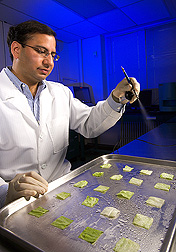Bacteriophages as Novel Antimicrobials for Food Safety
|
|
Houseguests sometimes overstay their welcome to the point that their hosts are just dying for them to leave. Now, this is actually happening to foodborne bacteria after viruses called “bacteriophages” take up residence inside them and begin replicating. The progeny of these bacteriophages literally kill their bacterial hosts on their way out the cellular door.
The bacteriophage research is being conducted by microbiologist Manan Sharma, with the ARS Food Safety Laboratory, Beltsville, Maryland, in collaboration with researchers at Intralytix, Inc., based in Baltimore, Maryland. Intralytix isolates environmental phage viruses and selects candidates for further study. Sharma tests their ability to infect and kill bacteria.
The word “bacteriophage” was coined much earlier by researchers in Europe to mean “bacteria eater.” These phages are environmentally ubiquitous and only attack bacteria. They do not have known adverse effects on humans, animals, or the environment.
Interest in bacteriophages is ramping up with the emergence of antibiotic-resistant organisms. Every day, we consume small amounts of insignificant, nonpathogenic viruses that adhere to our food. While human friendly, the heavily researched, purified viruses that Sharma is testing can wreak havoc on deadly bacteria, such as E. coli O157:H7, that sicken consumers.
Such novel antimicrobials could eventually become an asset to the fast-growing fresh-cut produce industry, which provides packaged sliced fruits and bagged salads.
Phages reproduce by insinuating themselves into bacteria. The viral DNA is injected into the cells of the bacterial hosts, where it directs the production of progeny phages. These phages burst from bacterial-host cells, killing them along the way, and then move on to infect more bacterial cells.
Sharma has completed testing a cocktail of phages (ECP-100) on refrigerated samples of fresh-cut cantaloupe. These trials indicated that the phage treatments could be effective in killing E. coli O157:H7 in a produce commodity. “The treatments reduced pathogens on the samples of fresh-cut cantaloupe by 100-fold over untreated controls,” says Sharma.
He has also tested the phages on their prime target: refrigerated fresh-cut lettuce. The results indicate that bacteriophage treatments can kill E. coli O157:H7 on the surface of leafy greens at the same levels as on the fresh-cut cantaloupe.
The laboratory’s researchers assess the prevalence, diversity, and quantity of enteric bacteria associated with produce. They also assess how these pathogens interact with fresh produce in growing environments to learn how problems can be managed to prevent foodborne illnesses. The new findings increase understanding of ways that bacteriophages might further improve food safety.—By Rosalie Marion Bliss, Agricultural Research Service Information Staff.
This research is part of Food Safety, an ARS national program (#108) described on the World Wide Web at www.nps.ars.usda.gov.
Manan Sharma is with the USDA-ARS Food Safety Laboratory, 10300 Baltimore Ave., Bldg. 201, Beltsville, MD 20705-2350; phone (301) 504-9198, fax (301) 504-8438.
"Bacteriophages as Novel Antimicrobials for Food Safety" was published in the July 2008 issue of Agricultural Research magazine.







